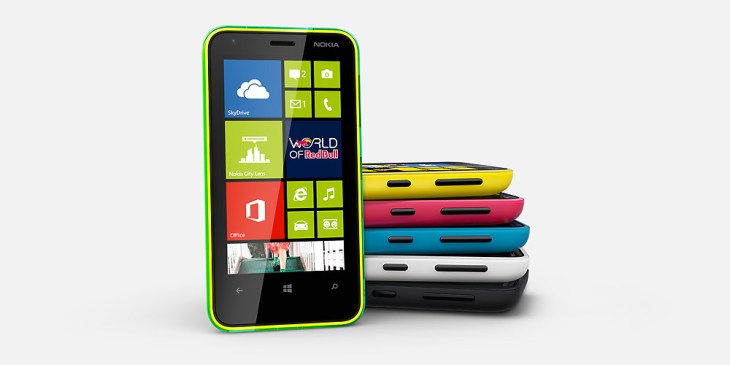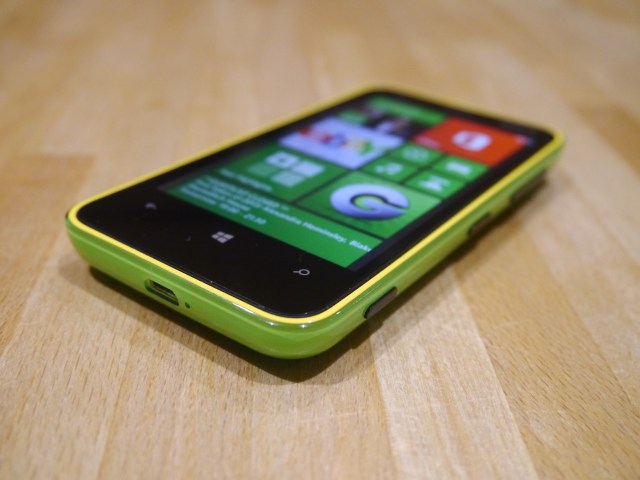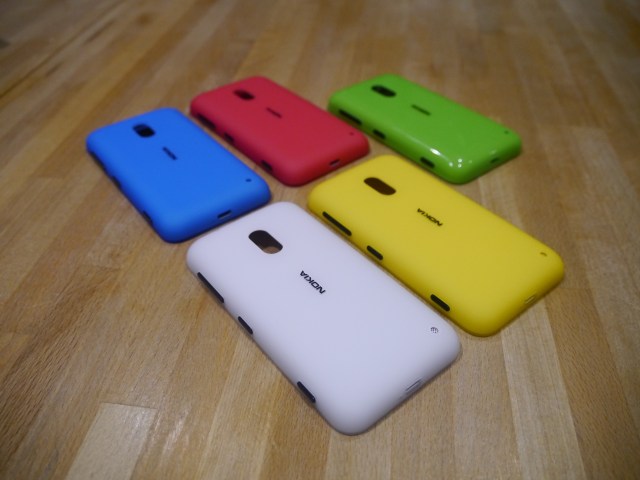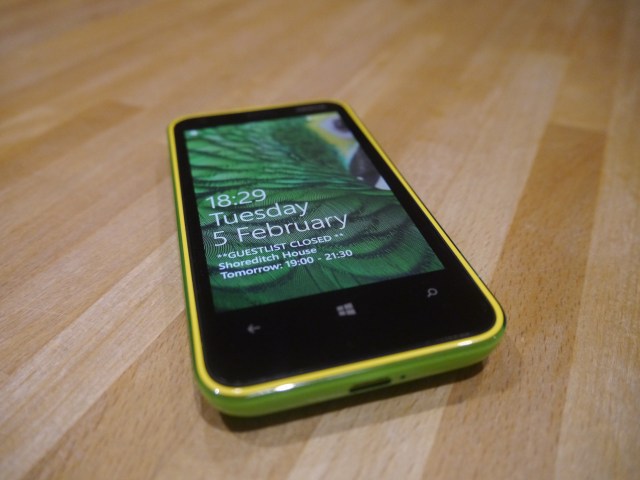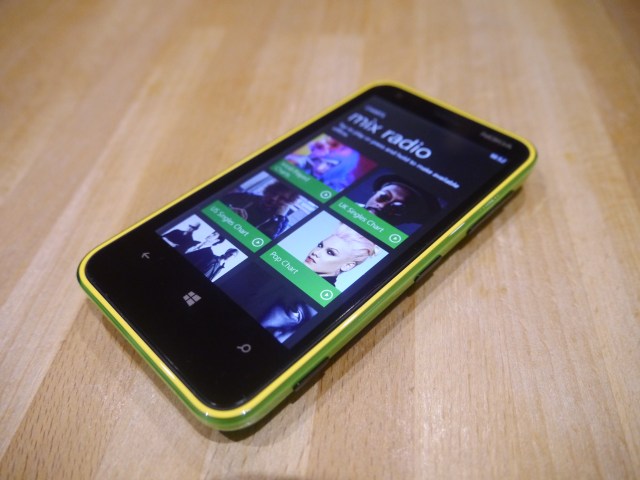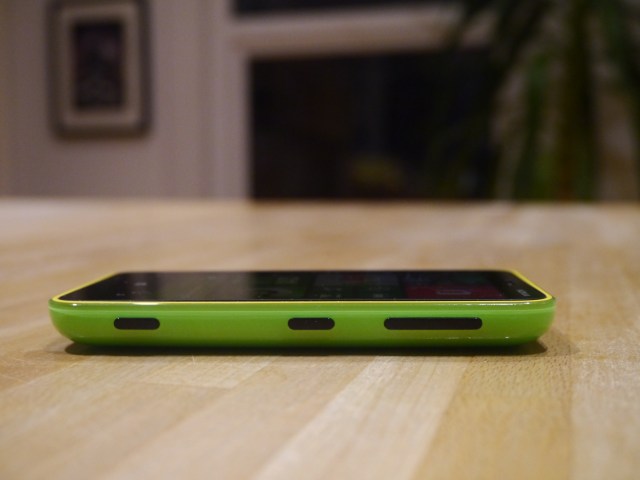The Nokia Lumia 620 is not a flagship smartphone — for high-end Windows Phone hardware, look to the Lumia 920 (or Samsung Ativ S). But what makes the 620 interesting is its (low) price: this is an entry-level handset that puts a polished mobile computing experience in your pocket without breaking the bank or compromising usability with dire, underpowered hardware.
When Nokia unveiled the 620 back in December it talked about wanting to add something more compact to its lineup. And the phone is certainly pocket-friendly. But the size of the 620’s price-tag is the real focus here: the Lumia 620 is Nokia’s cheapest Windows Phone 8 device by far (the Lumia 510 is cheaper still but that handset runs WP7.5/7.8, not WP8). Nokia’s target markets for the 620 are currently Asia-Pac, the Middle East and Africa, Europe and Canada. The company won’t comment on whether it will be bringing the handset to the U.S. in the future.
Driving down the cost of Windows Phone hardware so it can better compete with Android’s reach is a key plank of Nokia’s strategy. “We are clearly innovating with Microsoft around Windows Phone, and are focused on taking that to lower and lower price points,” said CEO Stephen Elop, on a Q4 investor conference call last month, adding: “You will see that over time compete with Android.”
The 620 is a crucial step along that road. In the U.K. it’s on offer SIM-free from £150 (approximately $235) — which means it’s lining up against a swathe of mid-range to budget Androids, while avoiding scraping along the very bottom of the budget barrel. At sub-£100, most phones are dismal performers — with sluggish processors, cramped low res screens and plasticy build quality — but even around the £150 mark there are plenty of duds. The Lumia 620 stands out from the underpowered crowd by showing that an entry level smartphone can get the performance basics right.
- 3.8 inch, 800 x 480 display with 246ppi
- Dual-core 1GHz Snapdragon S4, with 512MB of RAM
- 8GB of internal storage, expandable via MicroSD card up to 64GB, plus 7GB in Microsoft SkyDrive cloud storage
- User-replaceable 1300 mAh battery
- 5MP rear camera, front-facing lens for video calls
- Runs Windows Phone 8
Nokia said “compact” and the Lumia 620 is certainly that. It will slip into pockets and fit in the daintiest of hands. While its screen size is a smidgen bigger than the iPhone 4/4S — at 3.8 inches on the diagonal — its overall footprint is almost identical, albeit a little thicker in the waist (at 11mm). The screen itself is clear and bright without being especially crisp, thanks to its midding resolution.
On the design side, the phone has a rounded look and feel. And while there’s no getting away from how much plastic is involved in its construction it feels sturdy rather than flimsy. All its curves, coupled with the glossy shell, can make it a bit of a slippery character — it managed to fly from my fingers and crash-land on the floor during testing (but seemed no worse for wear after its tumble). The gently rounded back also means it won’t lie flush with a flat surface, such as a table, so if you try to use the touchscreen without otherwise anchoring it the handset will move/spin with your fingers.
Nokia has decided to go all out for bright and bold with the overall look of the phone by offering a range of vividly coloured shells, including a glossy two-tone acid green/yellow one (pictured in close up above, and below top right) and bright pink, blue, yellow and white in a matte finish (pictured below). Shells are swapped out by pressing on the camera lens while pulling back on the top edge.
As easy as it is to swap the shells it does feel a little gimmicky but if you’re the sort of person who likes to colour-match all your accessories then it might excite you. More exciting is that Nokia has released 3D print files for the case shell of another Lumia handset — the 820 — so it’s possible the company might also decide to release a 3DK for the 620 in the future (although the 620’s shell incorporates the headphone jack unit so it seems unlikely).
Being plasticy, the 620 is relatively lightweight (127g). It has three physical keys on its right-hand edge: a power/wake-up button in the middle, a volume rocker at the top and a dedicated camera button — which is a great addition — towards the bottom. On the front, you get the familiar trio of Windows Phone navigation keys: back; the Windows home key; and (Bing) search. These aren’t physical keys but the symbols have been printed atop the touchscreen so they’re visible at all times.
There’s a five megapixel camera on the rear of the phone, with a single LED flash. Photo resolution is 2,592 x 1,936 pixels and picture quality is average to poor — with subjects often acquiring a fuzzy halo and lacking crisp definition. It’s fine for quick snaps for uploading to Facebook etc. but is not an area where the 620 wins any plaudits. The front-facing lens produces extremely low-quality shots so is really only suitable for low-resolution video chatting.
Elsewhere, there’s a 3.5mm headphone jack on the top edge; a Micro-USB port for charging/transferring files on the bottom edge; and a small rear speaker on the back, towards the bottom corner. The Micro SD card slot can be got at by removing the shell (but without having to take out the battery). The Micro SIM tray is tucked away under the battery. Talking of which, the phone has reasonable stamina for its class. Nokia reckons you’ll get up to 9.9 hours of 3G talk time, or 61 hours of music playback on a single charge. I found it easily lasted a day’s average use.
Call quality is reasonable although not stand out — sounding a little muffled, rather than super crisp. The rear speaker wasn’t bad either, for such a budget device, with no evidence of distortion at the top of the range and the ability to pump the noise up relatively loud.
The Lumia 620 runs Windows Phone 8, which sets it apart from other low-cost Windows Phone handsets as these tend to run the previous incarnation of Microsoft’s mobile platform, Windows Phone 7 (either 7.5 — or the last update, 7.8, which includes the new, more flexible homescreen found on WP8). If you don’t have a huge budget and simply must have Windows Phone 8 the Lumia 620 is pretty much your only hope right now. At least until Huawei’s “entry-level” Ascend W1 arrives to rain on its parade.
Microsoft’s OS has positioned itself as a ‘third way’ to the smartphone ‘duopoly’ of Android and iOS, claiming WP is less controlling than Apple’s iOS, but more controlled than Android’s free for all. In truth, Windows Phone can feel very micro-managed since Microsoft doesn’t allow its OEMs to skin the OS with their own UI, meaning every Windows Phone looks and feels exactly the same.
If you like the Windows Phone look — big, bright tiles coupled with lashings of typography, rather than icons/graphics — then that’s not necessarily a problem. But it can feel like a bit of an acquired taste and/or rather clinical. Microsoft also, inevitably, lards the OS with made-in-Redmond services — which brings advantages, such as 7GB of free SkyDrive cloud storage (in the 620’s case), but can also feel a bit limiting. Want to make the search key default to Google rather than Bing? Forget it.
Still, there’s no denying Windows Phone offers something different to the competition, with social networking data (from Facebook, Twitter et al) working like the blood in its veins, continually pumping personalised updates onto your homescreen, and trickling down through native apps such as the calendar. All told, it’s the lazy person’s way to stay in the loop. Add to that, there’s no shortage of messaging options — with the built-in social networking extending your communications options so you don’t have to dive off into dedicated apps as you swipe around the UI. Web browsing also feels fast and responsive.
At the Lumia 620’s price point, the main OS alternative is of course Android — but at this price Nokia’s handset is effectively competing on performance grounds, rather than UI/OS philosophy. Far too many cheap Androids can feel sluggish and underwhelming, if not downright frustrating thanks to poor hardware. That’s not universally true of course — there are exceptions — but budget Android buyers need to do their research to avoid owning a lemon.
What the Lumia 620 shows is that Windows Phone can be an attractive low-price alternative — offering slick entry-level performance, with a solid browser, messaging, maps and of course integrated social networking, plus, in the 620’s case, value-add extras such as free cloud storage and Nokia’s free streaming music service.
As an OS, Windows Phone still has work to do — it’s solid but not glitch free — nor is it lightning fast on the 620, with the loading animation a constant companion, though never for too long. But, on the plus side, it’s really easy to use and, most importantly, packs in a lot of functionality for your cash. But — but! — you do need to make your peace with its relative lack of apps.
That cool new app your friend told you about? It won’t be on Windows Phone. Not now, and maybe not ever.
Windows Phone had some 150,000+ apps at the last count (vs more than 700,000 Google Play apps as of October last year) so, just looking at the numbers (ignoring the whole ‘app quality’ issue), it is very far behind the Android experience. Relative lack of apps remains a very big caveat about Windows Phone. That said, not all Android apps can run (or run well) on every budget handset so again, on performance grounds, the 620 can still make a compelling case for budget buyers.
There are still some seriously big holes in the Windows Phone app catalogue, such as Instagram and Dropbox, along with plenty of disruptive startup apps you’re inevitably missing out on such as Snapchat and Vine — but at this budget price it does feels a bit indulgent to gripe.
Nokia has also stepped into the app breach to bolster the platform with offerings such as its (free) Mix Radio music streaming service, which includes an offline listening feature and does not require any kind of registration to get the tunes up and running, along with Nokia Maps and turn-by-turn sat-nav app Nokia Drive (with free downloadable world maps), plus the likes of City Lens: an augmented reality app that helps you hunt for stuff in your local area.
Gaming seems to be a particularly weak area for Windows Phone apps (despite its Xbox-branded games hub) so the Lumia 620 is not such a great choice for pocket gamers. But — elsewhere — Microsoft has managed to get some big name apps on the platform, including Skype, Facebook, Twitter, Whatsapp, Evernote and Angry Birds. The latter does not appear to be offered as a free ad-supported download on Windows Phone, as it is on Android and iOS — presumably because of Windows Phone’s limited marketshare — so you’ll need to be prepared to spend around £0.79 ($1.24) to download each Rovio title.
One more thing: generally speaking, apps do tend to be more expensive on Windows Phone which is something else budget buyers need to factor in to their evaluation of the 620. There’s no doubt apps are Windows Phone’s weakest link.
The Lumia 620 is an impressive smartphone for the price. Its dual-core chip delivers decent all-round performance with responsive web browsing, maps and apps, and a UI that’s a pleasure rather than a sluggish chore to swipe around. Budget buyers are all too often fobbed off with underpowered, undesirable hardware that makes for uninspiring, frustrating software. This entry-level phone says there is another way to put the mobile web and smart messaging in your pocket.
But the trade-off is an ecosystem that feels a little more sterile than Android, both in terms of how much it lets you customise the experience to your tastes and the extent to which you can extend and augment it with third-party apps. There’s no denying Microsoft’s platform falls short on apps. But, at this entry-level price at least, the Lumia 620 makes up for that with solid performance and simplicity. Decent performance may partly be down to Windows Phone lacking the processor-draining apps to really push it. But even if that’s the case the result is a budget phone that, unlike some entry-level fodder, does the basics well — and that’s a great start.
